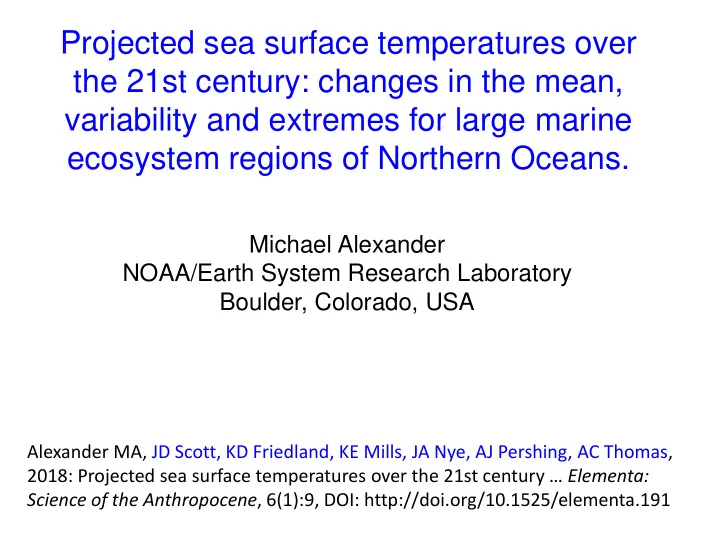

Projected sea surface temperatures over the 21st century: changes in the mean, variability and extremes for large marine ecosystem regions of Northern Oceans. Michael Alexander NOAA/Earth System Research Laboratory Boulder, Colorado, USA Alexander MA, JD Scott, KD Friedland, KE Mills, JA Nye, AJ Pershing, AC Thomas, 2018: Projected sea surface temperatures over the 21st century … Elementa: Science of the Anthropocene , 6(1):9, DOI: http://doi.org/10.1525/elementa.191
Motivation • Strong interest in SST variability and change among marine ecologist & fishery scientists in addition to climate scientists. – Example: Poleward movement of fish populations along the US east coast. – Concern now extends beyond just the change in the mean. – Extremes could be as or more important • e.g. thermal thresholds reached - Coral bleaching • Notion: “All extremes are getting more extreme”, true? • Examine change in mean and the variability of SSTs • Focus on Large Marine Ecosystems (LMEs) – Ocean areas along continental margins whose ecology is characterized by similar in bathymetry, hydrography, and biological productivity”
Methods • Climate change – RCP8.5 scenario after 2005, examine 1976-2099 • 26 CMIP5 Climate Models • 30 simulations NCAR CESM Large-Ensemble – Only very small perturbations in the initial conditions – Differences only due to internal variability • Monthly SSTs and also Mixed Layer Depth (MLD)
SST trends 1976-2099 (°C/decade) CMIP5 CESM-LENS
CMIP5 Median SST trends (°C/decade) in Large Marine Ecosystem (LME) regions
N. America SST Trends CMIP5 & CESM-LENS 1976-2099 °C/decade Box & Whisker low, 25%, 50%, 75%, high
N Atlantic SST Trends CMIP5 & CESM-LENS 1976-2099 °C/decade Box & Whiskers low, 25%, 50%, 75%, high
CMIP5 SST Seasonal Cycle, Annual Mean Removed Departure from Annual Cycle (°C) % Change in Annual Cycle Obs – green; CMIP5: 1977-2005 black; 2070-2099 red; % change blue Subtropical & Midlatitude regions 4%-8%; high latitudes > 20% increase in seasonal cycle
CMIP5 LME SST trends in each calendar month (#s) as a function of mean MLD Midlatitude LMEs High latitude LMEs SST trend °C per decade MLD (m) MLD (m) Subtropical LMEs similar but with less seasonal MLD variation
CMIP5 SST Variability ( σ ) March September 1976-2005 1976-2005 2070-2099 2070-2099 σ 2 ratio σ 2 ratio
Example CMIP5 SSTA PDFs (Histograms) relative to 1976-2005 2070-2099 2070-2099 1976-2005 mean Δ with mean Δ subtracted SSTs first detrended in each 30-year period
Monthly SSTA PDFs All CMIP5 Models Black:1976-2005 Red Solid 2076- 2099 with mean Δ Red dashed 2076-2099 with mean Δ removed
Monthly SSTA PDFs All CMIP5 Models Black:1976-2005 Red Solid 2076- 2099 with mean Δ Red dashed 2076- 2099 with mean Δ removed
Summary • Upward SST trends over the 21 st century – Spread in trends much greater in CMIP5 than in CESM-LENS: physics > natural variability for generating SST variability – Trends greater in summer than in winter especially mid and high latitudes => amplifies the Seasonal cycle of SST • Due in part to the mean seasonal cycle of MLD • Modest changes in variability – Large mean shift, small changes in PDF • All extremes not more extreme • Except where sea ice disappears and portions of N. Atlantic
Recommend
More recommend